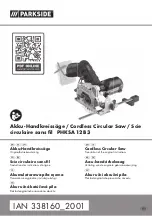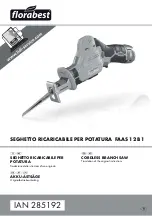
21
working.
1.6.14. When cutting processed sawn wood or thin branches use support (sawing horse).
Do not cut several boards at the same time (placed one on top of another), or material held by
other person or held with foot.
1.6.15. Long objects should be firmly fixed before cutting.
1.6.16. In uneven, sloping terrain proceed with your work when facing upwards.
1.6.17. When cutting through always use the bumper spike as a point of support. Hold the
saw by the rear handle and guide with the front handle.
1.6.18. In case the cut cannot be completed in one run, pull the saw a little back, put the
bumper spike in another place and continue the cut lifting rear handle slightly.
1.6.19. When cutting in horizontal plane, position yourself at an angle as close to 90º from
cutting line as possible. Such operation requires concentration.
1.6.20. When the chain is pinched when cutting with the tip of the bar, the saw may recoil
towards operator. Because of this effect cut with the straight part of the chain whenever
possible. Then, in case of pinching, the recoil effect changes direction away from the operator.
1.6.21. Be very careful when cutting wood when there is the risk of splitting. Pieces of wood
that are cut off can be flung in any direction (risk of body injury!).
1.6.22. Only trained persons should cut tree branches! Uncontrolled fall of a tree branch
constitutes a risk of body injury!
1.6.23. Do not cut with tip of the guide bar (risk of recoil).
1.6.24. Pay special attention to branches under strain. Do not cut branches, which hangs
freely, from below.
1.6.25. Always stand to the side of predicted fall line of the tree that is to be cut.
1.6.26. During a tree fell there is a risk that branches of the tree, or trees in proximity, will
break and fall. Be very careful, otherwise a body injury may occur.
1.6.27. On a sloped terrain the operator should stay on upper part of the slope with respect
to the tree being cut, never lower.
1.6.28. Watch out for logs that may roll down towards you. Jump away!
1.6.29. Operating saw tends to rotate when tip of the chain guide bar touches processed
material. In such case the saw may get out of control and move towards the operator (risk of
body injury!).
1.6.30. Do not use the saw above your shoulder level, or when standing on a tree, ladder,
scaffold, trunk etc.
1.6.31. Avoid touching the muffler. Hot muffler may cause severe burns.
1.7. To prevent saw recoil follow below instructions.
1.7.1. Never start or guide a cut with the tip of the guide bar!
1.7.2. Always start cutting with saw previously switched on!
1.7.3. Ensure the cutting chain is sharp.
1.7.4. Never cut more than one branch at a time. When cutting off, watch out for surrounding
branches. When cutting a tree through, watch out for nearby tree trunks.
2. Construction and use.
Petrol chain saw is a hand-held tool. It is driven by an air cooled, two-stroke combustion
engine. Tool of this type is designed for tasks in home garden. The saw can be used for cutting
down trees, cutting branches, firewood, wood for fireplace and other tasks where cutting wood
is necessary. Petrol chain saw is a tool for amateur use only.
Use the device according to the manufacturer’s instructions only.
3. Preparation for operation.
3.1. Carrying the chain saw.
Prior to carrying the chain saw slide chain cover onto guide bar and chain. When carrying
the chain saw, hold it by front handle. Do not carry the saw when holding main handle. If
several cuttings are to be made, switch off the chain saw with the ignition switch between
consecutive tasks.
3.2. Installation of guide bars and saw chain.
Prior to guide bar installation remove plastic transport spacer, placed on guide fixing
















































